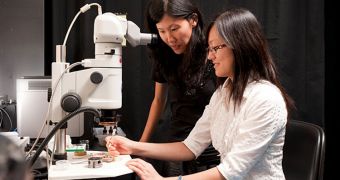A team of physicists from the Stanford University announces the creation of a new type of amorphous carbon, which was obtained in an experimental setup under extreme pressures. The researchers say that the material rivals diamond in terms of harshness.
However, the amorphous structure this form of carbon has isn't nearly as well organized as the crystalline structure inside diamonds, which makes the new achievement all the more remarkable.
The group that made the discoveries was led by Stanford mineral physicist Wendy Mao, and graduate student Yu Lin. “Sometimes amorphous forms of a material can have advantages over crystalline forms,” Lin explains.
Scientists have been using diamonds for a wide variety of applications other than jewelry for a long time, but they have also been aware that the material has some intrinsic flaws. Its crystalline structure, while extremely tough, contains planes of weakness that can severely reduce its applications.
By designing and synthesizing a material that features an amorphous structure, investigators basically circumvented this issue, creating carbon that is as tough as diamond, but has none of its flaws.
“With diamond, the strength depends on the direction a lot. It's not a bad property, necessarily, but it is limiting. But if diamond is amorphous, it may have the same strength in all directions,” Mao says.
The new material combines the extremely lightweight of carbon structures with the uniform hardness that can be found nowhere else in nature. In other words, the compound is just like diamond, except that it also has a few extra features.
In past investigations, researchers were only able to create bi-dimensional forms of amorphous carbon. However, their products contained hydrogen impurities and other contaminating chemicals, a fact that only made them suitable for a limited range of practical applications.
The Stanford team managed to circumvent these issues with help from colleagues at the Carnegie Institution of Washington (CIW). Details of the collaborative effort will be published in an upcoming issue of the esteemed journal Physical Review Letters.
“The amorphous diamond survived a pressure difference of 70 gigapascals – 700,000 atmospheres – which only diamond has been able to do. Nothing else can withstand that sort of stress difference,” Mao goes on to say.

 14 DAY TRIAL //
14 DAY TRIAL //